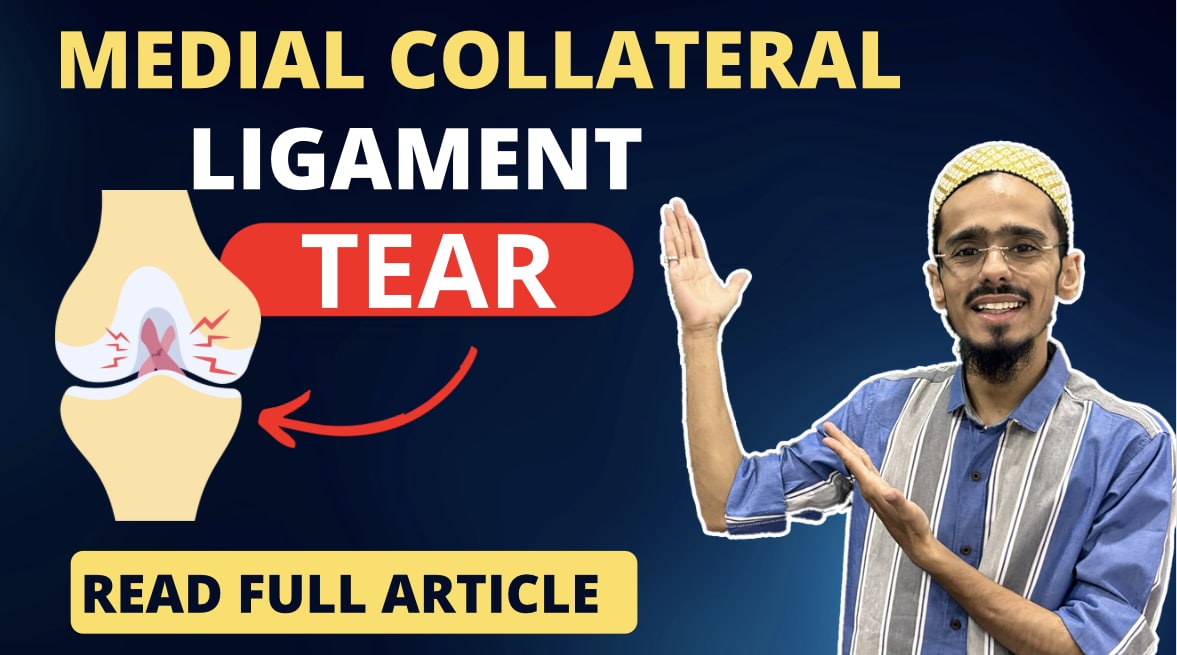Medial Collateral Ligament Tear
A medial collateral ligament (MCL) tear is a common injury that affects the ligament on the inner side of the knee.
The MCL provides stability to the knee joint and helps prevent excessive sideways movement.
MCL tears often occur due to a direct blow to the outer side of the knee or from a twisting motion that places stress on the ligament.
Symptoms of an MCL tear may include:
- Severe Pain on the inner or medial side of the knee joint .
- Swelling and tenderness.
- Instability or abnormal feeling of the knee giving way.
- Difficulty bending or straightening the knee.
- A burst or tearing feeling at the time of injury.
The severity of an MCL tear can range from mild to severe depending on the extent of the damage.
MCL tears are commonly classified into three grades:
- Grade 1: The ligament is stretched but not torn completely.
- Grade 2: This is the partial tear of the ligament.
- Grade 3: The ligament is completely torn, resulting in knee instability.
Treatment for an MCL tear depends on the severity and Extent of the injury.
Recovery time for an MCL tear
Recovery time for an MCL tear varies depending on the severity of the injury and the chosen treatment approach.
Mild to moderate tears typically take several weeks to a few months to heal.
while severe tears may require several months of rehabilitation before returning to normal activities.
It is important to consult with your Doctor
such as an orthopedic specialist or sports medicine physician, Physiotherapist for an accurate diagnosis and appropriate treatment plan for an MCL tear.
They can evaluate the injury, recommend imaging if needed and guide you through the recovery process.
Test to identify medial collateral ligament tear
There are several tests that can help identify a possible medial collateral ligament (MCL) tear.
While these tests can provide valuable information it is important to note that a definitive diagnosis should be made by a medical professional
such as an orthopedic specialist , Physiotherapist or sports medicine physician.
Here are a few common tests that may be conducted:
Valgus Stress Test: In this test, the examiner applies pressure on the outer side of the knee while the leg is slightly bent.
If there is significant gapping or pain on the inner side of the knee, it may indicate an MCL tear.
Palpation: The examiner may palpate (feel) the inner side of the knee to check for tenderness, swelling or any abnormality in the MCL area.
Lachman Test: This test is used to assess the integrity of the anterior cruciate ligament (ACL) the Lachman test indicate the MCL involvement.
The examiner stabilizes the thigh while applying a forward force to the lower leg, assessing the amount of forward movement and potential gapping at the inner side of the knee.
MRI (Magnetic Resonance Imaging): While not a test that can be performed on the spot, an MRI can provide detailed images of the knee’s soft tissues, including the ligaments.
It can help confirm the presence and severity of an MCL tear.
Remember these tests can help evaluate the possibility of an MCL tear.
But an accurate diagnosis should be made by a healthcare professional based on a combination of physical examination, patient history and possibly imaging studies like an MRI.
Physiotherapy Treatment in MCL tear
Physiotherapy plays a crucial role in the treatment and rehabilitation of a medial collateral ligament (MCL) tear.
The goals of physiotherapy for an MCL tear are to reduce pain and swelling, restore knee mobility and strength, improve stability and facilitate a safe return to normal activities.
Here are some common components of physiotherapy treatment for an MCL tear:
Initial management:
In the acute phase the physiotherapist may recommend the R.I.C.E. protocol (Rest, Ice, Compression, Elevation) to reduce pain and swelling.
They may also provide crutches or recommend partial weight-bearing to protect the injured knee.
Range of motion exercises:
Once pain and swelling subside the physiotherapist will guide you through gentle range of motion exercises to restore normal knee movement.
These may include heel slides, knee bends and gentle stretches.
Strengthening exercises:
Strengthening the muscles around the knee joint is crucial for stability and supporting the healing MCL.
The physiotherapist will design a personalized exercise program targeting the quadriceps, hamstrings and calf muscles.
Examples of exercises include leg presses, step-ups, hamstring curls and calf raises.
Balance and proprioception training:
Regaining balance and proprioception (awareness of joint position) is essential for restoring stability and preventing future injuries.
Your physiotherapist may incorporate exercises using balance boards, wobble cushions or unstable surfaces to challenge your balance and improve joint control.
Functional exercises:
As you progress, the physiotherapist will introduce functional exercises that mimic real life movements and activities.
These exercises aim to restore functional strength, agility and coordination specific to your daily and sports-related activities.
Taping or bracing:
In some cases, taping or bracing the knee may be recommend to provide additional support and stability during the healing process.
Your physiotherapist can guide you on the appropriate taping techniques or recommend a suitable knee brace if necessary.
Gradual return to activity:
Once your knee has regained strength, stability and range of motion
The physiotherapist will guide you through a gradual return-to-activity program.
This program will involve progressively increasing the intensity and complexity of your activities while monitoring your knee’s response.
It’s important to follow your physiotherapist instructions and progress at a pace that allows proper healing and minimizes the risk of reinjury.
The duration of physiotherapy treatment for an MCL tear varies depending on the severity of the tear and individual factors.
Regular communication with your physiotherapist is essential to track progress, address concerns and adjust the treatment plan as needed.
